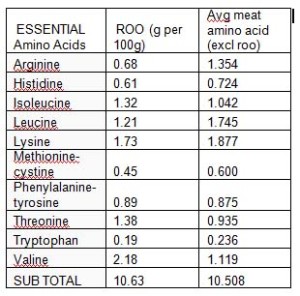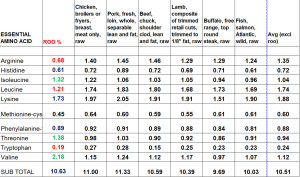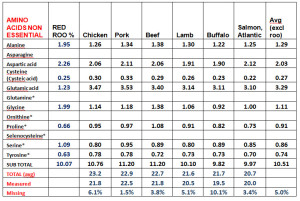Kangaroo meat Protein amount (amino acids) DOG TREATS compared to beef, chicken, pork, salmon, buffalo
 There are very few articles that provide the amino acid (protein) profile of kangaroo meat, let alone compare it to other meat amino acids. This article uses a very rare reference source for kangaroo meat amino acids values, and compares its amino acid profile with that of common meats used in dog food.
There are very few articles that provide the amino acid (protein) profile of kangaroo meat, let alone compare it to other meat amino acids. This article uses a very rare reference source for kangaroo meat amino acids values, and compares its amino acid profile with that of common meats used in dog food.
I originally concentrated on analyzing the amino acids in kangaroo meat because this is something that cannot easily be replicated or replaced in dog food. You can easily shove a bunch of artificial vitamins and generic minerals into dog food to make it pet food compliant, but you cannot copy or beat the natural amino acid chains in kangaroo meat.
The problem with kangaroo protein (amino acid) comparisons is that globally there has been almost NO research provided to back up the benefits of Kangaroo protein except for a paper I eventually tracked down from the 1970’s.
If you have any concerns about its accuracy or authenticity, then you will be happy to read an answer that I received on this matter. The data provided in the research paper is for the ” amino acid profile for Red kangaroo. The article might be old from the 1970 but honestly the mutation percentage in amino acid profile is 2% every 1,000,000 years. So I think there will not be much difference in the result since 1970.” (an anon scientist)
Just quantitative amounts (% of amino acid in a meat) gives you little understanding of the quality of the protein, however kangaroo meat has been recognized globally by many vets for its high quality proteins, not just the component amino acids that make up these proteins.
For comparison of the amino acid levels I used data from nutritiondata.self.com for chicken, pork, lamb, beef, buffalo and salmon. You can just as easily find amino acid data for your preferred meat (but not kangaroo).
The table below shows the 22 amino acids that make up protein. Of these 22, TEN are called ESSENTIAL amino acids because they cannot be synthesized in the body. Note that if your protein source happens to also provide exceptional levels and quality of non essential amino acids, a lot of stress is taken off the dogs body in having to manufacture the non essential amino acids – so it can concentrate on other things, like utilizing the amino acids or providing health immune functions.
Four of the non essential amino acids are missing from every profile due to measurement difficulties.
In the next article on this site I compare the AAFCO (US dog food standards) minimum amino acid % requirements so you have an indication of how brilliantly kangaroo meat (and kangaroo dog treats) exceed the minimum levels. If you didn’t know better you might suspect that the aafco minimum levels were kept relatively low to accommodate a lot of cheap vegetable protein sources (grains), in manufactured dog food.
The great implication from the high level of amino acids in kangaroo meat is that it doesn’t take much quality kangaroo dog treats (such as roo jerky) to be added to a manufactured dog food diet, to make a significant increase to its protein (amino acid) values.
Curiously Tryptophan is the only amino acid in the essential amino acid in the kangaroo amino acid table that was not measured. Even if this amino acid was in low quantities, since this paper is suggesting the consumption of kangaroo meat dog treats as a dog food nutritional supplement, its overall possible deficiency would not sufficiently affect the dogs diet. A scientists I discussed this with suggests that the missing amount might be 3 moles.
Use of kangaroo dog treats as a dog food supplement
This will be discussed in detail elsewhere, suffice to say up to 25% of a dogs diet can be replaced with meat before it fails the aafco minimum nutrient requirements.
You should be aware that while red kangaroo meat was tested at only around 20% protein, meat typically includes 75% water. If a dog treat such as kangaroo jerky is 100% kangaroo and almost all of the water is extracted, the protein amount can be estimate to around three times the wet meats value, or 60% plus protein.
The average protein content of meats
The protein content recorded in data tables for any meat source can vary considerably between different data sources. This is because the protein can be measured from different breeds of the same animal such as cow, cuts of meat from different places on the animal, different ages, levels of health, food sources etc.
These missing pieces of data and the variability of data based on the above reasons meant that it was important to baseline all of the different meats. I did this by finding as many trusted sources of protein data tables as I could and averaged them all for each meat type. The result is shown in the table below.
Protein percentage in raw meats
| Meat Type | A | B | C | D | Average |
| Kangaroo | 24 | 21.4 | 23.6 | 24 | 23.25 |
| Lean Lamb | 22 | 20.8 | 22 | 21.6 | |
| Lean Beef | 22 | 23.9 | 22.7 | 22 | 22.65 |
| Lean Pork | 23 | 23.2 | 22.3 | 23 | 22.875 |
| Lean Chicken Breast | 23 | 22.3 | 24.4 | 23 | 23.175 |
| Salmon | 20.7 | 20.7 | |||
| Buffalo | 21.7 | 21.7 |
Reference
A http://www.kangaroo-industry.asn.au/products/nutrit.htm
B http://www.mrsupplement.com.au/best-protein-sources
C http://juxtable.com/meat-protein-comparison/
D http://www.lowchensaustralia.com/health/kanga.htm
Kangaroo meat amino acid Calculation method
We want to find the absolute amounts of the kangaroo amino acids so that we can compare kangaroo to the another meats amino acids.
Given the Average protein value for Kangaroo meat (from FOUR sources) we want to work backwards to calculate the TOTAL amino acids comparable to the nutrition data website data values (amino acid values available for all meats except kangaroo).
Measured amino acids = Essential amino acids + non essential amino acids
Total amino acids = Measured amino acids + missing non essential amino (four)
Note the four missing amino acids are those that are not measured or recorded in any nutrition data tables (they are difficult and unreliably measured). However since they are non essential (can be created inside of the body) this is not such an issue for analysis, as long as they are accounted for in total grams.
For kangaroo meat we have the estimated average total amino acids (from the four reference sources) and the ratio of Essential to Non essential amino acids (from MAIN source)
So the we first need to find the missing non essential amino acids value (percentage) to calculate the TOTAL amino acid, and then the absolute mg of each essential amino acid.
ESTIMATES USED:
From ‘nutrition data’ tables: Using five common meats used in dog food the average % missing amino acids is 5.7% this value is used as a proxy estimate for the kangaroo meat amino acid.
Measured amino acid / TOTAL proteins = 94.1%
Using Kangaroo raw meat: Measured Amino acids / 23.3 mg = 94.1%
Therefore ‘Measured amino’ = 21.9 g per 100g raw kangaroo meat
Total Amino acids = measured amino acids + missing amino acids (4)
Total Amino acids = (Essential amino acids + non essential amino acids) + 5.7% (missing amino)
Essential amino acids + non essential amino acids = 21.9 x (94.3%) = 20.7 g
Knowing the fraction of each essential and non essential amino acid of the total amino amounts we can estimate the absolute mg value of each kangaroo amino acid
For a fair comparison, all of the amino acids for all the other meats are adjusted based on their AVERAGE total protein values in the above table. The table shows g per 100g (percentage)
Kangaroo meat amino acid (protein) DISCUSSION
Digestibility and high bio availability of the protein in meat is one of the main reasons the domestic, carnivore, dog should eat meat.
It is noted that from an extensive journal search only ONE kangaroo (red roo) amino acid data table was found. For the same reason that so many varied total amino acid values were found for the other meats (protein varies based on food stock, age, specific sub breed of the species etc).
The main point of this article is to explore how the ESSENTIAL amino acid absolute values are likely to compare with other meat types, and what the potential benefit of the roo essential amino acid profile is likely to provide.
This article discusses the amino acids that make up the meat proteins, since the proteins are not specifically mentioned by name, and they are broken down into their component amino acids for the body to use anyway.
Since the body (human, dog etc) cant manufacture the Essential amino acids (ten) these are the ones that should be focussed on in any nutritional analysis. Non essential amino acids are a ‘nice to have’ since their inclusion means that the body does not have to work hard at manufacturing its own versions.
Kangaroo Essential amino acids that are above average
- Isoleucine (1.3 V 1.0)
- Threonine (1.4 V 0.9)
- Valine (2.2 V 1.1)
Lower than average in
- Arginine 0.68 V 1.4)
- Leucine (1.2 V 1.7)
- Tryptophan (0.19 V 0.24)
Summary table: Kangaroo Essential amino acids 100g raw meat versus Meat Average.
| ESSENTIAL Amino Acids | ROO (g per 100g) | Avg meat amino acid (excl roo) |
| Arginine | 0.68 | 1.354 |
| Histidine | 0.61 | 0.724 |
| Isoleucine | 1.32 | 1.042 |
| Leucine | 1.21 | 1.745 |
| Lysine | 1.73 | 1.877 |
| Methionine-cystine | 0.45 | 0.600 |
| Phenylalanine-tyrosine | 0.89 | 0.875 |
| Threonine | 1.38 | 0.935 |
| Tryptophan | 0.19 | 0.236 |
| Valine | 2.18 | 1.119 |
| SUB TOTAL | 10.63 | 10.508 |
CONCLUSION and limiting amino acids
Based on this knowledge you may wonder what is so wonderful about kangaroo protein.
Besides all the other health benefits of kangaroo meat and its high digestibility and bio availability what you really want from your ‘dog food’ is that it has all of the essential (and preferably non essential) amino acids well in excess of the bare minimum requirements.
The minimum requirements are technically called limiting amino acids. This means that there are minimum levels of ALL TEN essential amino acids that should be consumed by a dog to ensure that it gets what it needs to grow, repair and maintain basic health functions.
If ONE of the essential amino acids falls below the bare minimum value then it will limit how effectively the other amino acids can be used (since they work together to form new proteins etc). All of the kangaroo meat essential amino acids are higher than the AAFCO dog food requirements.
The next article will discuss how grains in dog food are used to just reach the bare minimum essential amino acids levels.
High protein vegetables exist, but they can be expensive or not very palatable for your average dog, even when baked at high temperatures and coated in oil. That is why cheap grains are used in dog food as a filler.
THIS is why using Kangaroo meat, and kangaroo dog treats is such a good idea for you and your dog. If you use manufactured dog food that is low in meat, it may struggle to achieve a readily digestible amount of essential amino acids.
If you use meat, or a raw meat diet you WILL NOT have an issue with reaching the protein (and essential amino acid requirements) however in a commercial dog food diet, you are most likely going to get beef or chicken or lamb. The table in this article shows you what amino acids these common meats are high in, however you are likely to be getting 20% maximum dry meat in your kibble dog food bag.
The next article will look at kangaroo meat (and other meats) in comparison to grains used in dog food, and how they compare with each other and the AAFCO minimum essential amino acid guidelines. NOTE while 20% protein may seem like a low value, this is for raw meat. When meat is dried (removing close to the 75% of water it is usually composed of) the protein values often exceed 60% (dry weight).
By using a rarer meat such as kangaroo by way of dog treat, you are ensuring that any of the essential amino acids that might be on the low side that your common meat in the dog food provides will be perfectly supplemented by the kangaroo meat (with its quite different amino acid profile).
That is, any amino acid that the dog food (and included meat) might be low on, will be perfectly supplemented by the unique amino acid profile of kangaroo meat, and the amino acids that are well in excess of the average amino values in common meats.
Importance of: leucine C6H13NO2 & Valine
“Previous studies have indicated that a dietary source of each of the branched-chain amino acids, leucine, isoleucine and valine, is essential for growth of immature dogs. Deletion of dietary leucine, isoleucine or valine resulted in weight loss, depressed food intake and negative nitrogen retention. Branched-chain amino acids are not only substrates for protein biosynthesis but also have been implicated to have various functions in the regulation of protein turn over and energy metabolism. An additional feature of the branched-chain amino acids is that their catabolism in mammals is initiated in muscle, a tissue that is relatively inactive in the degradation of most other amino acids” ref 4
Reference
All common meat amino acid profiles from http://nutritiondata.self.com
Kangaroo amino acids data from: GLYCERALDEHYDE-3-PHOSPHATE DEHYDROGENASE FROM THE RED KANGAROO (MEGALEIA RUF A): PURIFICATION AND THE AMINO ACID SEQUENCE AROUND A REACTIVE CYSTEINE By R. J. SIMPSON* and B. E. DA VIDSON* [Manuscript received September 2, 1970]
Ref .Leucine, isoleucine and valine requirements of immature beagle dogs. Burns RA, Garton RL, Milner JA. 1984 Jan;114(1):204-9 http://www.ncbi.nlm.nih.gov/pubmed/6693979




